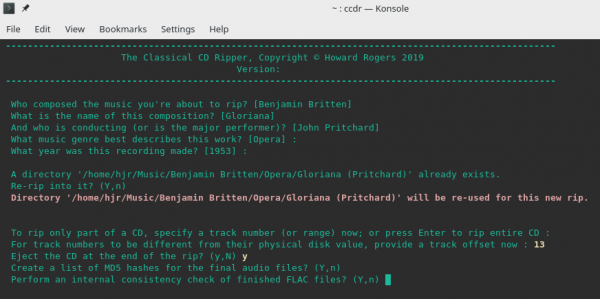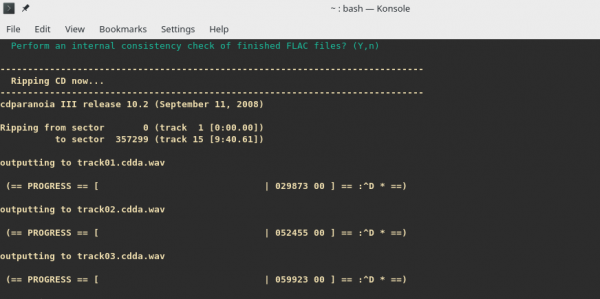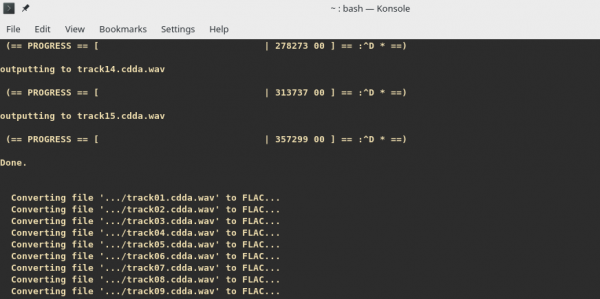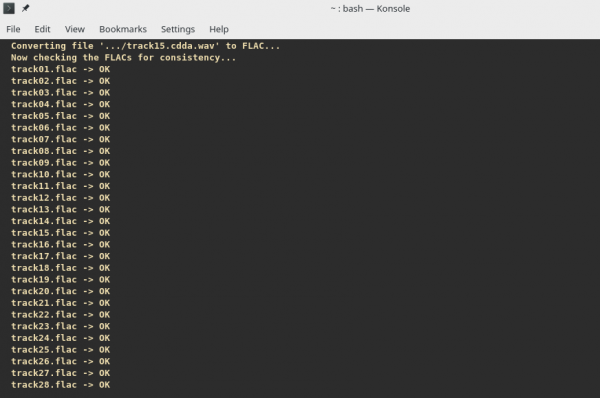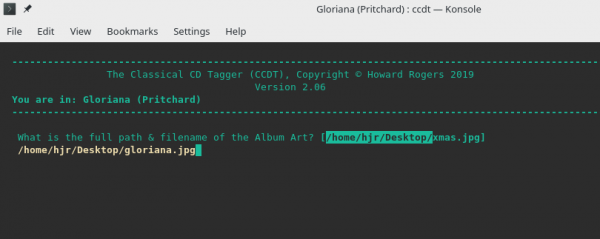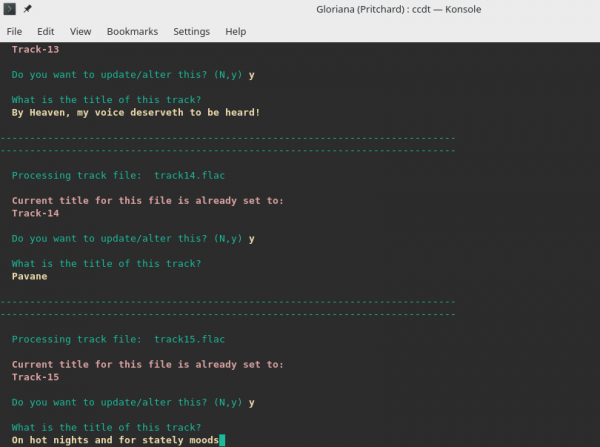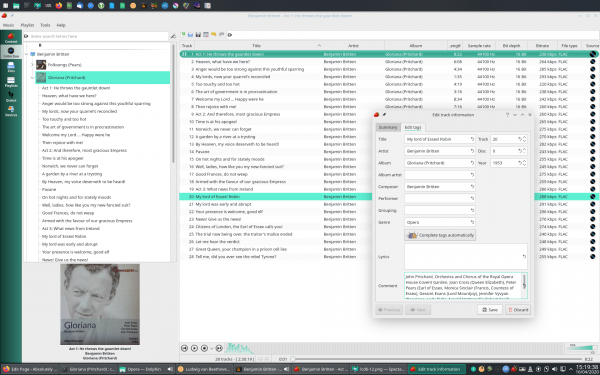1.0 Introduction
This is the sixth article in my series showing how I would suggest you go about the business of ripping and tagging different CDs of varying configurations. Previously, I’ve discussed various ripping scenarios that all have one thing in common: the work or works being ripped were all supplied on a single CD.
In this article, however, I want to examine how you might go about ripping and tagging the following work:
In case it's not obvious, that's a recording of a three-act opera by Benjamin Britten -and three acts tend not to fit on a single CD! Sure enough, here's the inside of the accompanying booklet:
You will notice at once that the piece is supplied as part of a 2-CD set and that Act 2 of the opera is split between CD1 and CD2. When a single work is spread over multiple CDs, special ripping considerations must apply, since if you left the ripper software to its own devices, you'd end up (in this case) with a track called 01-He throws the gauntlet down! and 01-Pavane.
From the perspective of the various Axioms of Classical Music this site advocates, however, that would be quite wrong. This is a single composition and it's irrelevant how many physical CDs it happens to be supplied on. When we finish track 13 at the end of the first CD, we should move straight on into track 14, the pavane that starts CD 2. Only then do we obey Axiom 9, which states that a composition is an album and every album starts with "a" track 1, not two or more of them!
Our task when we rip and tag this opera, then, is to make sure that none of the tracks on CD2 conflict or over-write the tracks we have previously ripped from CD1. Additionally, we need to make the track numbers sequential across all CDs in the set, with none re-initializing the sequence at 1 after the first CD. With those goals in mind, let's see how we'd go about ripping this work.
2.0 The Rip
The rip, using CCDR, will get a lot of these considerations sorted for us without too much drama. The first CD is ripped in perfectly normal fashion:
The composer, composition name, principal artist (i.e., the conductor), genre and recording year are all specified quite simply. The track number prompt is left empty, to indicate that the entire CD should be ripped. There are accordingly no track offsets. Everything else is set to the defaults -except that I ask for the CD to be ejected from my optical drive when I'm done with it.
The second CD of the opera set is ripped in quite a similar way:
Happily, we can re-use the answers supplied by lots of typing for the first CD by simply pressing [Enter] when they are offered as defaults for this second CD. So composer, composition, principal artist, genre and recording date can all just be re-used. Things get a lot more interesting when we get to the track-specific parts of CCDR's prompts, though! Firstly, we simply press [Enter] to select the entire CD to be ripped, as we did before: no track ranges are needed here.
But the track offset needs to be set very carefully! If we didn't put anything in here, then CD2's track 1 would over-write CD1's track 1 that's already sitting on my hard disk -and that would happen for all other tracks, too. By putting a 13 in at this point, however, I'm asking for CD2's track 1 to become my hard disk's track 14 (by adding 13 to it). That same +13 will happen for all other tracks on CD2, too, so that its tracks will be added on to the end of CD1's tracks, not replace them. When ripping starts of this second CD, it doesn't look too encouraging:
The display is still talking about tracks 1, 2 and 3 and so on! At the end of proceedings, too, it seems that the track offset has been ignored:
Track 15 is the last track on the second CD, so when it's been ripped, the files produced by the rip are converted to FLAC... and we're still apparently talking about tracks 1, 2, 3 and so on. But look what happens when the final FLAC consistency checks are performed:
Suddenly, we're talking about tracks 14 and onwards! This is the proof that the track offset has been applied after all: it only takes effect at the point that the files are converted to FLAC and tagged with the composer, composition and genre details you supplied to CCDR. Meanwhile, since CD2's 15 tracks have been ripped to the same physical location on disk that CD1's original 13 tracks were ripped to, there are now a grand total of 28 tracks in the folder which need to be checked for FLAC internal consistency -so all 28 get checked (meaning that the first 13 tracks end up being double-checked!)
The key point here, really, is the use of correct track offsets. I used one of '13' here to make sure that the tracks ripped from CD2 didn't over-write those previously ripped from CD1 (which ended at track 13). I used a number which, when added to the physical track number 1 of the second CD, would therefore result in a new hard disk track number of 14 and up. If this had been an opera supplied on 3 CDs, then when I ripped CD3 (knowing that I'd arrived at hard-disk track 28 at the end of CD2), I would have needed to supply a track offset of 28, so that CD3's track 1 became hard disk track 29. And let us imagine that CD3 had, say, 12 tracks on it, so that once ripped, our hard disk folder would now contain 40 tracks; then, in that case, CD4 would be ripped by using a whole-disk rip with an offset of 40, so that CD4 track 1 would become hard disk track 41.
Do you see, then, that the track offset you supply when ripping second and subsequent disks in a set is always the highest track number you already have on disk at that point.
Understanding this principle of track offsets is the key ingredient to getting multi-CD rips of a single work performed without drama.
So, at this point, CCDR has neatly ripped 2 CD's-worth of tracks into the same directory on your hard disk -and made sure that the second CD's track numbers flow on consecutively from the point where CD1's tracks originally got to. We thus end up with 28 tracks belonging to one composition, not 13+15 tracks ripped as two distinct entities.
3.0 The Tagging
Naturally, we now finish things off with a run of the Classical CD Tagger (CCDT) in the newly-created directory on disk. CCDR gets most of the tag information correct, but cannot accurately provide performer details, track names or album art. So, in CCDT, as usual at this stage of proceedings, we need to take options 3, 6 and 8 in turn. Here's me filling in some of the performer details for this opera:
My point with this screenshot is to show you that I can supply a lot of performer information! I just keep typing and the text wraps onto multiple lines... but there's no practical limit to what I can type, so no matter how long the lines get, just keep typing! If you make a mistake, however, I suggest you submit the erroneous text and re-take option 3 and start from scratch. Don't try editing what you've typed -especially if it means trying to get back to lines above the one you're on- as results can be a little unpredictable.
Adding the album art is standard fare:
Since my album art tends to always come from scans or downloads that I save to my desktop, I can re-use most of the path remembered by CCDT the last time I ran it. So here you see me highlighting the '/home/hjr/Desktop/' part of my earlier response. I can then copy-and-paste that down into the yellow text section and just type the 'gloriana.jpg' bit of the path/filename combo that is needed at this point. CCDT's display of a previous run's data should be exploited to cut down the amount of typing you are needed to do afresh, in other words.
Finally, option 8 lets me type in new track titles to replace the generic ones provided by CCDR:
There's not a lot of subtlety here, to be honest: the job consists of a lot of typing of track titles lifted straight from the CD booklet. The only concession I make to tagging up the tracks from these sorts of dramatic works (operas, ballets and so on), is to permit a short 'Act 1:' or 'Act 2:' prefix at the relevant time. I definitely do not indicate that the words 'He throws the gauntlet down' are sung by the character Henry Cuffe, performed on this recording by Ronald Lewis, for example! Remember Axiom 10: we aren't theatrical impresarios and don't need character names, stage directions or details such as "Act 1, Scene 1" included in our track title tags!
Updated to add (16th April, 2020) : Please note that CCDT has just been updated so that if it detects track titles in files which it knows to have been ripped by CCDR, it now will now not ask you if you want to edit or alter them, but will act as if the track title is blank. It will thus just ask you to supply a new track title and will auto-overwrite the generic title supplied by CCDR with whatever you supply. Given that CCDR's track titles are always 'generic' and meaningless, it seemed awkward to have to type 'y' every time you simply wanted to type a proper track title. The screenshots above and below show the old behaviour of requiring a 'y' response to the 'do you want to update/alter' question.
Here's the point in the track-tagging where the transition from CD 1 to CD 2 happens:
Blink and you'd miss it, of course! It's only by reference to the CD booklet that you'd ever know that CD1 ended at track 13 and track 14 was actually CD2's first track... which is really the point. Now that the tracks are all on hard disk, the concept of what disk they came from becomes irrelevant, and the track numbers should progress without interruption from 13 to 14 and onwards.
Incidentally, when you have a lot of track titles to type in, you're rarely going to get it right first time of asking! You can check your work in your file manager before you quit CCDT completely:
Here, for example, I notice that track 3 seems to have a typo in it: "Anger would be too strong against this youthful sparring" has been typed in as "Anger would be too string..." This sort of thing happens, unfortunately! It isn't a problem however: just use CCDT's option 8 a second time and press [Enter] to skip through tracks which have acceptable names until you get to the track that's wrong:
Type 'y' to say you would like to alter it, and then type in the correct wording. In this screenshot, I'm again exploiting CCDT's tendency to show you 'last run results': I have typed the "Anger would be too strong" bit in yellow, but the rest of the track title was entered in correctly -so I'm highlighting it in red from the line a few above the current one with my mouse. A bit of copy-and-paste will see me then re-construct a complete track title -this time with "strong" not "string"- without me having to type all of it in from scratch (though you could do that as well, of course, if your typing speeds make it worthwhile!) With one track corrected, you just keep your finger down on the [Enter] key to whiz through all the other tracks until you get back to the main menu.
Remember to use the 'q' option to quit out of CCDT in a 'clean' manner. This will perform a final 'clean' of the tags and an integrity test of the internals of each FLAC file in turn.
As ever, don't hesitate to check your work in your music player/manager:
Here, I see 28 consecutively numbered tracks, distinguishable (just!) into three separate Acts, sharing the same album art. The pop-up track information dialogue is also showing me that the track tags look good -though I can spot a missing bracket in my list of performers! That would be easily fixed by going back into CCDT and taking option 3 once more, though for the purposes of this current article, I shall leave that for another time and place!
4.0 Conclusion
I hope you see from all the foregoing that ripping a single work that is split across multiple CDs is really quite easy using CCDR: each CD gets ripped in its entirety; the composer, composition and genre details are supplied once, for the first CD, and re-used for each of the subsequent CDs just by pressing [Enter] when prompted for them. The 'secret sauce' that allows multiple CDs to be ripped to a single 'virtual album' is simply the appropriate use of track offsets. You supply a number that, when added to '1', allows the tracks from the second (or subsequent) CD to be appended to the existing set of tracks, rather than over-writing them. And that's basically the only thing that makes ripping a multi-CD work a slightly different proposition from anything we've met before. It requires a little mental arithmetic, but isn't exactly difficult, I think!
Meanwhile, tagging the complete set of tracks really is no different than before: CCDT comes to the rescue with its usual options 3, 6 and 8. There's a lot of typing of track titles to get right, true enough; but there's nothing fundamentally new about the way you use the tool.
Back to the Master Index of the Guides to Ripping and Tagging



